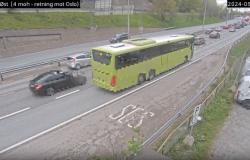Hangover and rush made me realize how cool hitchhiking is. It’s also good for the planet.
A while ago I was on a trip to Tromsø, where I visited friends and went skiing for a few days. It was very nice, but the trip home to Oslo on Sunday did not go quite as planned.
Ground a little extravagant birthday celebration until around five in the morning, I overslept and missed the bus that was supposed to take me from Tromsø to Fauske. There I was going to jump on the night train to Oslo to catch a lecture on Tuesday morning.
After one minute intense confusion and five minutes of suppressed rage (I’m from Sørlandet), I found out that the next bus left the following day, and that I was then too late to make it to both the lecture and work.
The bus trip to Fauske takes approximately eleven hours, but the drive only takes eight. A quick, but at the time demanding, mental calculation showed that I had a theoretical possibility of getting there before the night train whizzed away.
I put on my clothesgot out of the center and started hitchhiking.
Almost with one once stopped a car with a journalist from iTromsø, who wondered what I was doing. I explained the situation, he thought it was hilarious and wanted to make a case.
As everyone knows, are stories about southerners who screw up a kind of heroin for people from the north, so the story of the slightly tired southerner who tried to hitchhike from Tromsø to Fauske spread like wildfire in the local newspapers, and was eventually picked up by several national media.
After that national media coverage of the drunkenness trip, I received (besides tips about a better alarm app) many questions on social media and from people I met, probably also because I was presented as the hitchhiking climate scientist.
Because what was the point of traveling such a long distance by train, bus or hitchhiking rather than flying? Several wondered whether there is any climate benefit at all in taking a train or bus rather than flying.
It is a good question. And the short answer is yes.
There are many ways to measure emissions from passenger transport. The one that makes the most sense divides the CO₂ emissions by the number of passengers, so that, for example, a full plane is more climate-friendly than a half-full plane, while if you travel alone in a bus, you will get out of it badly.
If you compare transport methods in Norway with this goal, which SSB does annually, trains come out best.
Bus and car emits 9 and 10 times more, and airplanes emit 29 times more when looking at figures from 2019, which is the last year available without pandemic restrictions on public transport.
However, CO₂ is not the only thing emitted that affects the climate. Among other things, airstrips and production of ozone from exhaust contribute to more warming of the atmosphere. If you include this in the calculations, the difference increases slightly.
Diesel bus is for example 3-5 times better than flying. Unless you drive alone in a large diesel car and compare it to sitting in a new fuel-efficient car plane that is more than half full, it is, so to speak, always more climate-friendly to drive by car, bus or train.
A clear winner are electric trains on renewable energy.
Others who gave me feedback, pointed out that if I used an empty seat on a plane or in a car, the difference in emissions would be equal to zero anyway, since both car and plane make the trip and thus emit the CO₂ anyway.
This is not entirely truein that both car and plane have to use a little more fuel to transport my extra 110 kg of people and luggage, but that’s not too far from the truth.
The difference in emissions is relatively small.
However, it is so that the flight offer is governed by demand. So if demand falls, the number of flights will fall. As Tore Sagen once pointed out, it is not the case that the airlines will send lots of empty planes around the world if everyone stops flying.
This applies to a far lesser extent hitchhiking. Here you do not influence the market, and the argument that the emissions would have taken place regardless holds water.
In addition, it was damn nice to hitchhike down towards Oslo. All drivers and fellow passengers offered interesting conversations about everything from skiing in Lofoten, hot takes on the bread slice culture in Norway, scooter driving in Sweden, existential crises, British rap and Formula 1 in Budapest, to sheep in the mountains.
Sometimes you also get soft drinks from those you ride with.
After seven hitchhiking tripsan overnight stay on the pier in Rognan, a lasagna dinner in Trondheim and an unconscious night bus trip, I managed both work and a lecture on Tuesday morning.
All in all: Full throttle both socially, climate-wise and timing-wise.
Hitchhiking the following day is therefore better by almost all standards than flying the next day.
This opinion piece was first published at NRK ytring.
Tags: Hangover rush realize cool hitchhiking
-





